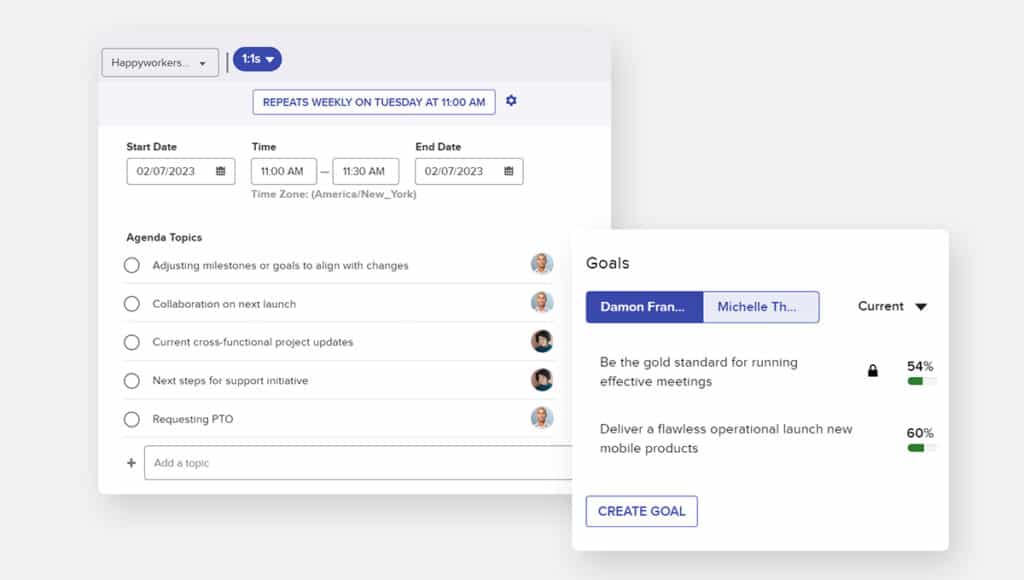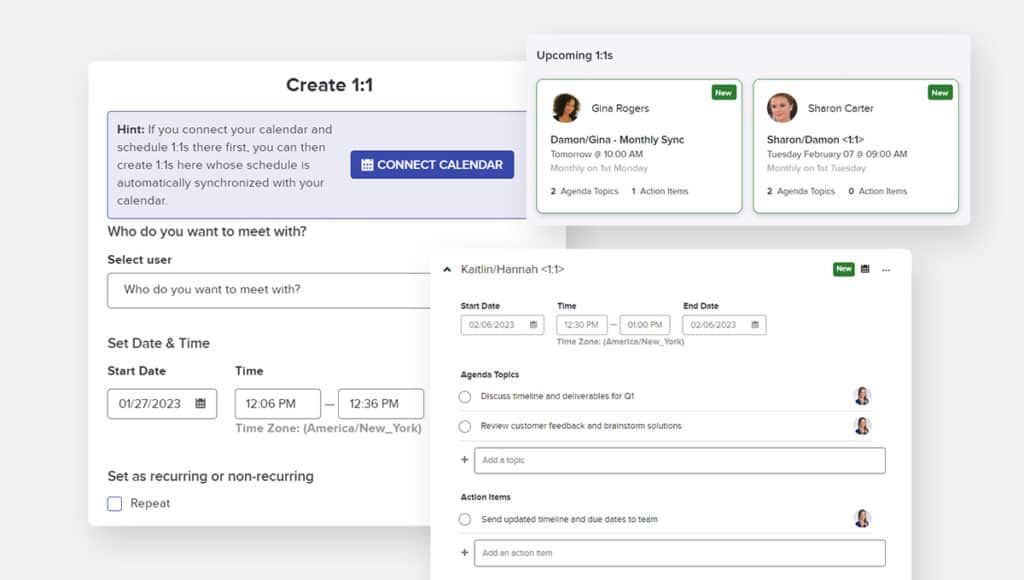Most of us have experienced the frustration of attending a meeting that feels like a waste of time. Maybe it’s a team meeting that drags on without any real purpose or a one-on-one discussion that goes off on tangents and never seems to achieve anything.
It’s no surprise, then, that research shows that 92% of employees consider meetings to be costly and unproductive. While people crave feedback and conversations with their manager, badly run one-on-one meetings can actually take a toll on their engagement and job satisfaction.
It doesn’t have to be this way. Let’s explore some of the common meeting missteps plaguing one-on-ones and how you can overcome them.
Lack of focus
Without a clear focus, meetings can drag on — wasting time without producing positive outcomes. Instead of homing in on one purpose and addressing it thoroughly, unfocused meetings may run through several topics without resolving any of them. That lack of focus keeps one-on-one conversations at a superficial level, which rarely benefits anyone.
A clear meeting agenda helps participants see what to prioritize during a one-on-one. Betterworks 1:1s module puts the agenda front and center, giving both parties a chance to contribute to the agenda in advance, see what’s most important to address and bring up items for discussion. This gives each participant ownership in the meeting.

A clear focus produces interpersonal benefits, too. By emphasizing outcomes and working together to achieve shared goals, one-on-one meetings help your people build connections while staying on task. These discussions empower important conversations across the entire company, whether an ad hoc peer-to-peer meeting for project collaboration or a regularly scheduled tactical catchup between a manager and their direct report. Effective 1:1 meetings help people feel more energized and supported so that they can get work done better and faster.
Inconsistent structure
The traditional one-on-one meeting between a manager and employee is an important opportunity to check in, build trust, and ensure that everyone is on the same page. However, managers often aren’t trained to plan, organize, and lead these meetings effectively.
Without a clear structure, meetings between managers and team members may meander and fail to address what’s most important. Without a clear structure, for example, a manager may jump right into discussing a topic without setting an agenda, identifying the meeting’s purpose, or outlining the benefits they expect an employee to take away from it — all ultimately leading to an unproductive session or one that is sub-par.
The Betterworks 1:1s module operationalizes great meeting habits by incorporating best practices into the organization’s culture — establishing clear meeting goals, setting an agenda, and documenting decisions, commitments, and next steps. Betterworks 1:1s makes these details available at a glance for managers, letting them focus on the conversation happening in front of them.

A weekly manager-employee check-in, for example, could revolve around the tactical agenda items and how each relates to the employee’s goals and priorities, visible in the shared side-by-side view of the agenda and the employee’s goals. When people can clearly see the purpose of the meeting, they’ll get more out of these conversations with their manager.
Betterworks 1:1s also automatically rolls over unaddressed or unresolved agenda items to the next 1:1 meeting so that nothing falls through the cracks. And agenda items can easily be added as they come to mind with the Betterworks plug-in for Gmail and Outlook, allowing employees to add topics and notes to upcoming 1:1s directly from their inbox.
Limited transparency and accountability
Since unfocused, unstructured meetings barely scratch the surface of an issue, they rarely produce any action items participants can apply. Participants often walk away from meetings knowing they have action items but are uncertain of the dependencies, need to improve their performance, or that an approach they’ve taken to a task isn’t working. But they rarely gain insights into the most important outcome from a one-on-one meeting: what they need to do next to progress. That lack of transparency and accountability for actions can be confusing and frustrating for employees.
When participants have the ability to generate action items in real-time during one-on-one meetings with software tools interconnected to goals and performance, like Betterworks, they see what steps they need to take in relation to their goals and objectives. The path to achieving their end goal becomes more concrete and their work more meaningful. When people stay focused on meeting outcomes rather than viewing the meeting itself as another task to complete, one-on-ones become a powerful tool for driving progress and achieving goals.
Learn more about Betterworks’ 1:1s and put an end to unproductive one-on-one meetings.


